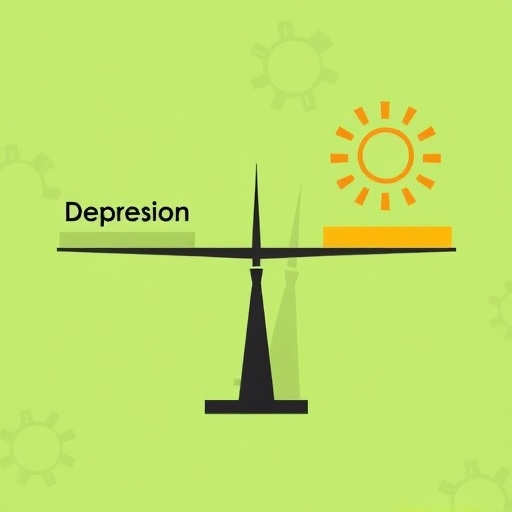In recent years, the mental health community has grappled with the challenge of accurately measuring mental wellbeing and distinguishing it clearly from symptoms of depression. This issue is crucial, as it influences both clinical assessments and treatment outcomes. A groundbreaking study published in BMC Psychiatry ventures into this complex terrain by investigating the discriminant validity of the Warwick-Edinburgh Mental Wellbeing Scale (WEMWBS) against the widely used Patient Health Questionnaire (PHQ-9). The study, anchored in rigorous statistical methodology and a substantial patient dataset, unveils insights that could reshape how mental health metrics are interpreted in clinical and research settings.
The core question driving this research is deceptively simple yet profoundly impactful: does the WEMWBS genuinely capture positive mental wellbeing as a construct distinct from clinical depression, or are these scales merely two sides of the same coin? Previous assumptions in the field often treated these metrics as independently valid measures, but empirical evidence on their overlap or divergence has been sparse and inconclusive. By employing advanced latent variable modeling techniques, this study brings new clarity to ongoing debates.
The research draws upon a sizeable cohort of 1,690 participants enrolled in Norway’s Prompt Mental Health Care (PMHC) program. PMHC operates as a low-threshold treatment service addressing mild to moderate anxiety and depression, making this population highly relevant for analyzing subtle distinctions between wellbeing and depressive symptoms. Notably, the majority of participants were women between the ages of 21 and 50, reflecting a demographic that commonly engages with mental health services.
Crucial to the study’s robustness is its application of structural equation modeling and bifactor analysis, which allow for an intricate examination of underlying latent constructs measured by the WEMWBS and PHQ-9 scales. These methods enable the disentanglement of shared and unique variances, distinguishing whether the scales assess overlapping affective states or independent psychological dimensions. Furthermore, MIMIC (Multiple Indicators, Multiple Causes) models evaluate how demographic variables relate to these constructs while accounting for measurement bias.
The results reveal a strikingly strong negative correlation between scores on the PHQ-9 and both the 7-item and 14-item versions of the WEMWBS. In latent model terms, this correlation approaches -0.80, signifying a substantial inverse association. Such a robust relationship challenges the notion that these tools measure orthogonal constructs, suggesting instead that higher wellbeing scores correspond closely to fewer depressive symptoms, and vice versa.
Expanding on this, psychometric indices derived from bifactor models indicate that when combined, the WEMWBS and PHQ-9 together form essentially a unidimensional spectrum rather than two discreet factors. This implies that positive mental wellbeing and depressive symptoms assessed through these scales might reflect opposite ends of a single underlying continuum rather than two independent psychological states. This finding upends simple interpretations of wellbeing as a wholly distinct positive construct.
Demographic analyses further reinforce these parallels, with relationships between demographic factors and PHQ-9 scores mirroring those seen with the WEMWBS—but with opposite signs, as expected given their negative correlation. However, when the variance attributable to a general depressive symptoms factor is statistically removed, associations between demographic variables and residual wellbeing scores diminish markedly. This observation points to a shared depressive symptom influence that permeates both measures.
Collectively, this study’s findings suggest that the Warwick-Edinburgh Mental Wellbeing Scale may lack sufficient discriminant validity relative to the PHQ-9 within this clinical sample. In effect, mental wellbeing, as captured by the WEMWBS, might not stand entirely apart from depressive symptomatology but rather be intertwined with it in these populations. These conclusions carry significant implications for practitioners and researchers aiming to accurately measure and intervene upon mental health constructs.
Technically speaking, the application of bifactor modeling here is particularly illuminating. Such models partition measurement variance into a general factor—often interpreted as a broad latent trait—and orthogonal group factors that account for additional construct-specific variance. In this context, the dominance of the general factor supports the notion of a shared underlying dimension of affective states encompassing wellbeing and depression rather than cleanly separable psychological entities.
The implications ripple beyond mere measurement theory. Clinically, if wellbeing and depressive symptoms lie along a unidimensional spectrum, treatment strategies might benefit from integrated approaches that simultaneously enhance wellbeing while reducing depression rather than compartmentalizing these goals. Moreover, researchers should exercise caution in interpreting WEMWBS scores as purely indicative of positive mental health distinct from psychopathology.
Future avenues of investigation should strive to replicate these findings across diverse populations and settings, including non-clinical samples and longitudinal designs. Exploring the stability of this unidimensional factor over time could shed light on whether wellbeing and depression dynamically interact or whether they separate under different circumstances or interventions. Additionally, refining measurement instruments or developing novel scales that better parse these constructs remains a priority.
Ultimately, this study stands as a critical contribution to the field of mental health measurement, challenging entrenched assumptions and encouraging a reevaluation of how psychological wellbeing and depression are conceptualized and quantified. Its rigorous methodological approach combined with a large, relevant sample offers a robust foundation upon which future research and clinical practice can build. As our understanding of mental health continues to evolve, such investigations will be invaluable in shaping more nuanced and effective approaches to mental healthcare worldwide.
Subject of Research: Discriminant validity of the Warwick-Edinburgh Mental Wellbeing Scale (WEMWBS) relative to the Patient Health Questionnaire (PHQ-9)
Article Title: Positive mental wellbeing or symptoms of depression? Discriminant validity of the Warwick-Edinburgh Mental Wellbeing Scale
Article References:
Aarø, L.E., Knapstad, M. & Smith, O.R. Positive mental wellbeing or symptoms of depression? Discriminant validity of the Warwick-Edinburgh Mental Wellbeing Scale. BMC Psychiatry 25, 487 (2025). https://doi.org/10.1186/s12888-025-06922-0
Image Credits: AI Generated




